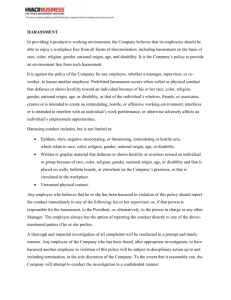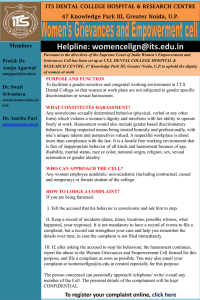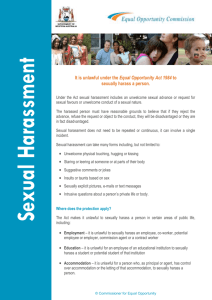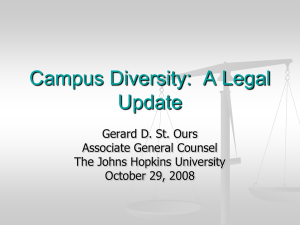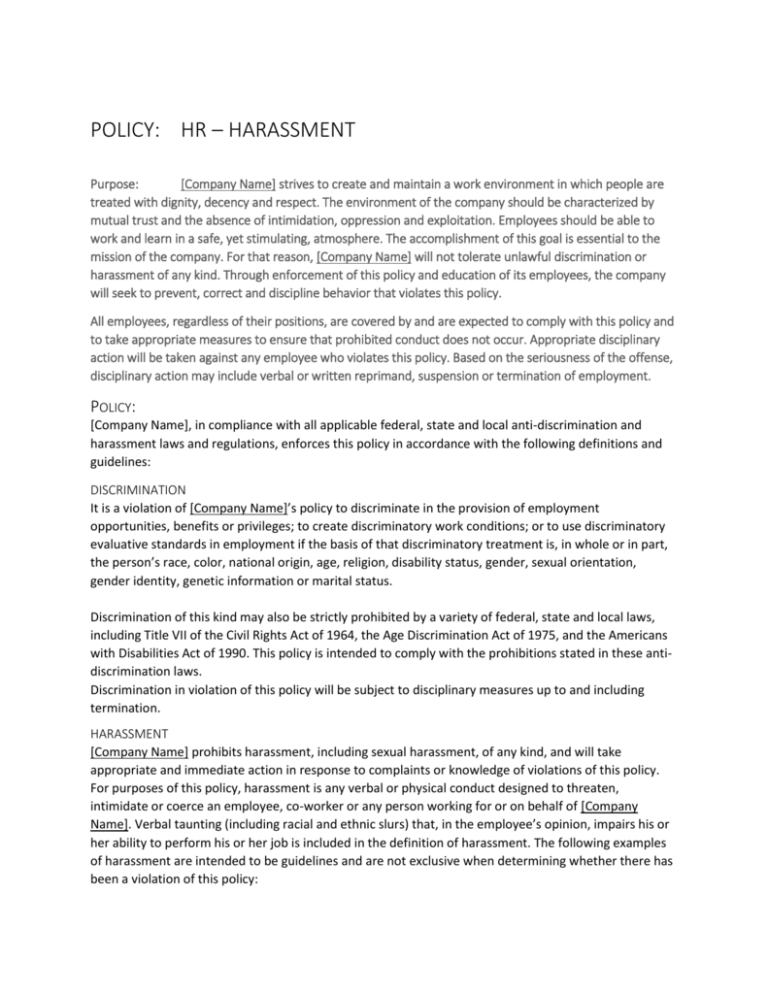
POLICY: HR – HARASSMENT
Purpose:
[Company Name] strives to create and maintain a work environment in which people are
treated with dignity, decency and respect. The environment of the company should be characterized by
mutual trust and the absence of intimidation, oppression and exploitation. Employees should be able to
work and learn in a safe, yet stimulating, atmosphere. The accomplishment of this goal is essential to the
mission of the company. For that reason, [Company Name] will not tolerate unlawful discrimination or
harassment of any kind. Through enforcement of this policy and education of its employees, the company
will seek to prevent, correct and discipline behavior that violates this policy.
All employees, regardless of their positions, are covered by and are expected to comply with this policy and
to take appropriate measures to ensure that prohibited conduct does not occur. Appropriate disciplinary
action will be taken against any employee who violates this policy. Based on the seriousness of the offense,
disciplinary action may include verbal or written reprimand, suspension or termination of employment.
POLICY:
[Company Name], in compliance with all applicable federal, state and local anti-discrimination and
harassment laws and regulations, enforces this policy in accordance with the following definitions and
guidelines:
DISCRIMINATION
It is a violation of [Company Name]’s policy to discriminate in the provision of employment
opportunities, benefits or privileges; to create discriminatory work conditions; or to use discriminatory
evaluative standards in employment if the basis of that discriminatory treatment is, in whole or in part,
the person’s race, color, national origin, age, religion, disability status, gender, sexual orientation,
gender identity, genetic information or marital status.
Discrimination of this kind may also be strictly prohibited by a variety of federal, state and local laws,
including Title VII of the Civil Rights Act of 1964, the Age Discrimination Act of 1975, and the Americans
with Disabilities Act of 1990. This policy is intended to comply with the prohibitions stated in these antidiscrimination laws.
Discrimination in violation of this policy will be subject to disciplinary measures up to and including
termination.
HARASSMENT
[Company Name] prohibits harassment, including sexual harassment, of any kind, and will take
appropriate and immediate action in response to complaints or knowledge of violations of this policy.
For purposes of this policy, harassment is any verbal or physical conduct designed to threaten,
intimidate or coerce an employee, co-worker or any person working for or on behalf of [Company
Name]. Verbal taunting (including racial and ethnic slurs) that, in the employee’s opinion, impairs his or
her ability to perform his or her job is included in the definition of harassment. The following examples
of harassment are intended to be guidelines and are not exclusive when determining whether there has
been a violation of this policy:
Verbal harassment includes comments that are offensive or unwelcome regarding a person’s
nationality, origin, race, color, religion, gender, sexual orientation, age, body, disability or
appearance, including epithets, slurs and negative stereotyping.
Nonverbal harassment includes distribution, display or discussion of any written or graphic
material that ridicules, denigrates, insults, belittles or shows hostility, aversion or disrespect
toward an individual or group because of national origin, race, color, religion, age, gender,
sexual orientation, pregnancy, appearance, disability, sexual identity, marital or other protected
status.
SEXUAL HARASSMENT
Sexual harassment is a form of unlawful employment discrimination under Title VII of the Civil Rights Act
of 1964 and is prohibited under [Company Name]’s anti-harassment policy. According to the Equal
Employment Opportunity Commission (EEOC), sexual harassment is defined as “unwelcome sexual
advances, requests for sexual favors, and other verbal or physical conduct of a sexual nature, when
submission to or rejection of such conduct is used as the basis for employment decisions or such
conduct has the purpose or effect of creating an intimidating, hostile or offensive working
environment.”
There are two types of sexual harassment:
“Quid pro quo” harassment, where submission to harassment is used as the basis for
employment decisions. Employee benefits such as raises, promotions and better working hours
are directly linked to compliance with sexual advances. Therefore, only someone in a
supervisory capacity (with the authority to grant such benefits) can engage in quid pro quo
harassment. Examples: A supervisor promising an employee a raise if she goes on a date with
him; a manager telling an employee she will fire him if he does not have sex with her.
“Hostile work environment,” where the harassment creates an offensive and unpleasant
working environment. A hostile work environment can be created by anyone in the work
environment, whether it be supervisors, other employees or customers. Hostile environment
harassment consists of verbiage of a sexual nature, unwelcome sexual materials or even
unwelcome physical contact as a regular part of the work environment. Texts, emails, cartoons
or posters of a sexual nature; vulgar or lewd comments or jokes; or unwanted touching or
fondling all fall into this category.
Sexual harassment occurs when unsolicited and unwelcome sexual advances, requests for sexual favors,
or other verbal or physical conduct of a sexual nature:
Is made explicitly or implicitly a term or condition of employment.
Is used as a basis for an employment decision.
Unreasonably interferes with an employee’s work performance or creates an intimidating,
hostile or otherwise offensive environment.
Sexual harassment may take different forms. The following examples of sexual harassment are intended
to be guidelines and are not exclusive when determining whether there has been a violation of this
policy:
Verbal sexual harassment includes innuendoes, suggestive comments, jokes of a sexual nature,
sexual propositions, lewd remarks and threats; requests for any type of sexual favor (this
includes repeated, unwelcome requests for dates); and verbal abuse or “kidding” that is
oriented toward a prohibited form of harassment, including that which is sexual in nature and
unwelcome.
Nonverbal sexual harassment includes the distribution, display or discussion of any written or
graphic material, including calendars, posters and cartoons that are sexually suggestive or show
hostility toward an individual or group because of sex; suggestive or insulting sounds; leering;
staring; whistling; making obscene gestures; or sending content in letters or notes, facsimiles, emails, photos, text messages, tweets, Internet postings, or other forms of communication that is
sexual in nature and offensive.
Physical sexual harassment includes unwelcome, unwanted physical contact, including touching,
tickling, pinching, patting, brushing up against, hugging, cornering, kissing and fondling, as well
as forced sexual intercourse or assault.
Courteous, mutually respectful, pleasant, noncoercive interactions between employees, including men
and women, that are appropriate in the workplace and acceptable to and welcomed by both parties are
not considered to be harassment or sexual harassment.
RETALIATION
No hardship, loss, benefit or penalty may be imposed on an employee in response to:
Filing or responding to a bona fide complaint of discrimination or harassment.
Appearing as a witness in the investigation of a complaint.
Serving as an investigator of a complaint.
Retaliation or attempted retaliation in response to lodging a complaint or invoking the
complaint process is a violation of this policy. Any person who is found to have violated this
aspect of the policy will be subject to sanctions up to and including termination of employment.
CONSENSUAL ROMANTIC OR SEXUAL RELATIONSHIPS
[Company Name] strongly discourages romantic or sexual relationships between a manager or other
supervisory employee and his or her staff (an employee who reports directly or indirectly to that
person), because such relationships tend to create compromising conflicts of interest or the appearance
of such conflicts. In addition, such a relationship may give rise to the perception by others that there is
favoritism or bias in employment decisions affecting the staff employee. Moreover, given the uneven
balance of power within such relationships, consent by the staff member is suspect and may be viewed
by others or, at a later date, by the staff member as having been given as the result of coercion or
intimidation. The atmosphere created by such appearances of bias, favoritism, intimidation, coercion or
exploitation undermines the spirit of trust and mutual respect that is essential to a healthy work
environment. If there is such a relationship, the parties need to be aware that one or both may be
moved to a different department, or other actions may be taken.
If any employee of [Company Name] enters into a consensual relationship that is romantic or sexual in
nature with a member of his or her staff (an employee who reports directly or indirectly to him/her), or
if one of the parties is in a supervisory capacity in the same department in which the other party works,
the parties must notify the Human Resources director or other appropriate corporate officer. Because of
potential issues regarding quid pro quo harassment, [Company Name] has made reporting mandatory.
This requirement does not apply to employees who do not work in the same department or to parties
who do not supervise or otherwise have management responsibilities over each other.
Once a relationship is made known to [Company Name], the company will review the situation with
Human Resources in light of all the facts (reporting relationship between the parties, effect on coworkers, job titles of the parties, etc.) and will determine whether one or both parties need to be moved
to another job or department. If it is determined that one party must be moved, and jobs in other
departments are available for both, the parties may decide who will be the one to apply for a new
position. If the parties cannot amicably come to a decision, or one party is not chosen for the position to
which he/she applied, the parties will contact Human Resources, which will decide which party should
be moved. That decision will be based on which move will be least disruptive to the organization as a
whole. If it is determined that one or both parties must be moved, but no other jobs are available for
either party, the parties will be given the option of terminating their relationship or resigning.
COMPLAINT PROCESS
[Company Name] will courteously treat any person who invokes this complaint procedure, and the
company will handle all complaints swiftly and confidentially to the extent possible, in light of the need
to take appropriate corrective action. Lodging a complaint will in no way be used against the employee
or have an adverse impact on the individual’s employment status. Because of the damaging nature of
harassment to the victims and to the entire workforce, aggrieved employees are strongly urged to use
this procedure. However, filing groundless or malicious complaints is an abuse of this policy and will be
treated as a violation.
CONFIDENTIALITY
The employee assistance program (EAP) provides confidential counseling services to company
employees. Individuals wishing to discuss an incident confidentially or seeking information and advice of
a personal nature are encouraged to contact the EAP. The role of the EAP in such cases will be limited to
personal counseling and treatment for the person who is then an EAP client. Contacting the EAP will not
qualify as notification to [Company Name] of a potential harassment or discrimination issue (see
complaint procedure below for more on how to notify the company of an issue or complaint).
During the complaint process, the confidentiality of the information received, the privacy of the
individuals involved and the wishes of the complaining person will be protected to as great a degree as
is legally possible. The expressed wishes of the complaining person for confidentiality will be considered
in the context of the company’s legal obligation to act on the charge and the right of the charged party
to obtain information. In most cases, however, confidentiality will be strictly maintained by the company
and those involved in the investigation. In addition, any notes or documents written by or received by
the person or persons conducting the investigation will be kept confidential to the extent possible and
according to any existing state or federal law.
COMPLAINT PROCEDURE
[Company Name] has established the following procedure for lodging a complaint of harassment,
discrimination or retaliation. The company will treat all aspects of the procedure confidentially to the
extent reasonably possible.
1. An individual who feels harassed, discriminated or retaliated against may initiate the complaint
process by filing a complaint in writing with [Company Name]’s Human Resources director. No
formal action will be taken against any person under this policy unless HR has received a written
2.
3.
4.
5.
6.
7.
8.
9.
10.
and signed complaint containing sufficient details to determine whether the policy may have
been violated. The complainant (the employee making the complaint) may obtain the complaint
form from the HR department. If a supervisor or manager becomes aware that harassment or
discrimination is occurring, either from personal observation or as a result of an employee’s
coming forward, the supervisor or manager should immediately report it to the HR director.
Upon receiving a complaint or being advised by a supervisor or manager that violation of this
policy may be occurring, the HR director will notify the company and review the complaint with
the company’s legal counsel.
Within five working days of receiving the complaint, the HR director will notify the person or
persons charged (hereafter referred to as “respondent(s)”) of a complaint and initiate an
investigation to determine whether there is a reasonable basis for believing that the alleged
violation of this policy occurred.
During the investigation, the HR director, together with legal counsel or other management
employees, will interview the complainant, the respondent and any witnesses to determine
whether the alleged conduct occurred.
Within 15 business days of the complaint being filed (or the matter being referred to the HR
director), the HR director or other person conducting the investigation will conclude the
investigation and submit a written report of his or her findings to the company.
If it is determined that harassment or discrimination in violation of this policy has occurred, the
HR director will recommend appropriate disciplinary action. The appropriate action will depend
on the following factors: a) the severity, frequency and pervasiveness of the conduct; b) prior
complaints made by the complainant; c) prior complaints made against the respondent; and d)
the quality of the evidence (e.g., firsthand knowledge, credible corroboration).
If the investigation is inconclusive or if it is determined that there has been no violation of policy
but potentially problematic conduct may have occurred, the HR director may recommend
appropriate preventive action.
Within five days after the investigation is concluded, the HR director will meet with the
complainant and the respondent separately, notify them of the findings of the investigation, and
inform them of the action being recommended.
The complainant and the respondent may submit statements to the HR director challenging the
factual basis of the findings. Any such statement must be submitted no later than five working
days after the meeting with the HR director in which the findings of the investigation are
discussed.
Within 10 days from the date the HR director meets with the complainant and respondent, the
company will review the investigative report and any statements submitted by the complainant
or respondent, discuss results of the investigation with the HR director and other management
staff as may be appropriate, and decide what action, if any, will be taken. The HR director will
report the company’s decision to the complainant, the respondent and the appropriate
management assigned to the department or departments in which the complainant and the
respondent work. The company’s decision will be in writing and will include findings of fact and
a statement for or against disciplinary action. If disciplinary action is to be taken, the respondent
will be informed of the nature of the discipline and how it will be executed.
ALTERNATIVE LEGAL REMEDIES
Nothing in this policy may prevent the complainant or the respondent from pursuing formal legal
remedies or resolution through local, state or federal agencies or the courts.
STATE AND FEDERAL REMEDIES
In addition to the above, if you believe you have been subjected to sexual harassment, you may file a
formal complaint with either or both of the following government agencies:
The United States Equal Employment Opportunity Commission
[Local USDOL Regional or District Office Address]
State Commission against Discrimination
Effective Date: _____________________________
Approved:
_____________________________
Last Reviewed: _____________________________
Date: ____________________




